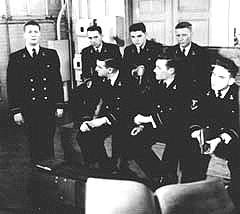 |
| Actor Fred Bier responding to his instructors questions in a scene from "Counterflood" with support from other actors and midshipmen, including Joe Taff and Phil Sullivan, Class of '56. |
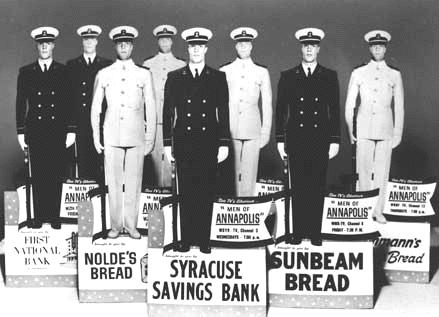
"Now, that was a TV Series, 'Men of Annapolis'!" so wrote Dick Couch '67 in response to my request to alumni for anecdotal memories of the only television series that has featured the Naval Academy. The syndicated series of half-hour dramatic episodes was televised nationwide initially during the 1957 television season. It was a program that many alumni credit for inspiring their interest in attending the Naval Academy. Bill Belden '67 said: "I imagine there are many guys like me who had their dreams and visions influenced by Men of Annapolis!" and Dave Lester '64 asserted: "Had there not been a Men of Annapolis series, I never would have thought to apply for an appointment... I'm certain there are many more like me." "Everything I did, after exposure to those programs," commented Bob Mullins '69, "I did with the goal in mind to someday win an appointment to Annapolis."
Back in early 1957, as a newly commissioned ensign and graduate of the Class of 1956, I was ordered from my permanent assignment aboard LOS ANGELES (CA-135) to temporary duty as "Technical Representative" for the Men of Annapolis production at ZIV Television studios in Hollywood. Forty years later in the summer of 1997, I decided to find out whatever happened to the films of the series and what impact the program may have had.
| After eventually locating the archives of the series at the Wisconsin Center for Film and Theater Research, I invited comments from alumni of the classes of '62 to '69, who had been in their middle school and high school years when Men of Annapolis was being televised. In response to my request via class networks and Shipmate columns, I received nearly 140 email comments. Although the responses represent only a relatively small percentage of the graduates of these classes, the nearly universal acclaim of this group of alumni for the series as a prime motivator for their interest in the Naval Academy seems to indicate that Men of Annapolis turned out to have been a far more valuable public information vehicle and recruiting tool than anyone realized at the time. |
|
Of the alumni who responded to the survey, an overwhelming majority—95%—stated with various degrees of assuredness that they were positively influenced to attend the Naval Academy by Men of Annapolis. Bill Owens '62 wrote: "Men of Annapolis had a profound effect on me. Living in North Dakota, I was working on a farm after high school graduation... I came home from the fields one evening, saw this wonderful place somewhere far away on the East Coast where the guys wore white uniforms and carried swords, and I said "that's for me!" He related the events which followed leading to his appointment to "the Naval Academy and a grand adventure which lasted 34 years, and blessed me with the 2nd highest position in the U.S. military." The comments of other alumni ranged from: "partial influence"; "motivating"; "one factor" to "great influence"; "instrumental"; "most important factor"; several echoed the comment of Pete Odell '62, "I can tell you absolutely and unequivocally that the reason I went to the Naval Academy is because of the TV series Men of Annapolis."
The stories of Men of Annapolis included light comedy as well as serious drama, with the inevitable Hollywood-imposed dramatic conflict. In October 1956, when production of the series was well along, the President of ZIV, John L. Sinn, in an internal memo, reemphasized ZIV's intentions for the series: "It is essential that we capture in this series the youthful virility, drive, action, conflict and enthusiasm that exists at Annapolis." Greg Quillinan ‘69 recalled: "Their [the stories] clear message—it's a good thing to be a Midshipman." Rick Arllen '69 wrote: "The show always projected the best aspects of USNA—tough but fair, perseverance leads to success, the hard right over the easy wrong."
Honor was the theme of the Men of Annapolis episode most remembered by alumni. It was titled "Honor Bright" and portrayed the story of a Plebe who, knowing he was unable to pass the gymnastics qualifying test, falsified his test results. The story showed the procedure followed by the Fourth Class honor committee, chaired by a First Classman, featuring dramatic dialogue by the Plebe accuser, actor Robert Blake. The story ended with the Plebe's dismissal from the Naval Academy with the narrator's comment: "Few people pay such a high price to learn the value of honor." The episode was so well thought of at the Naval Academy that it was obtained from ZIV and shown to entering Plebes for indoctrination into the honor system. Blake also appeared in another episode, "The White Hat," about a Plebe who reports to Annapolis from the fleet strongly motivated to become commissioned. "Some nights I'd lean against the rail and look up at the bridge . . . thinking what I'd give to be up there. Then my appointment to the Academy came. My insides felt like the 4th of July—roman candles, pinwheels, firecrackers, the works—all exploding inside of me."
The evolution of Men of Annapolis began in the Fall of 1955 when ZIV presented a concept for two weekly dramatic programs based on the Military Academy (titled West Point) and the Naval Academy to the Assistant Secretary of Defense, Office of Public Information. Filmmakers had been regularly using the Naval Academy as one of the most popular Navy stages for romance, comedy, and drama since release of the movie The Midshipman in 1925; however, this was the first opportunity to feature the Academy on television. Between 1925 and 1955, Hollywood produced some 17 movies involving the Naval Academy, apparently in agreement with comments made in Variety's review of The Midshipman. The critic predicted that anytime producers wanted to make a service-academy film, "it should be financially profitable as well as a boost for the schools. The Cadets and Middies are surefire subjects, always have been and always will be." ZIV may well have believed the same would hold true on television. The comments of alumni would seem to confirm the critic's prediction and ZIV's expectations: "Clearly the programs [both West Point and Annapolis] created an aura about the academies" (John Alich '64); "I... found the characters, the Midshipmen, to be great role models" (Doug May '66); "The Midshipmen were presented as men of honor and integrity" (Bill Robinson '69). On a somewhat different note, Steve Coester '63 commented: "After all there wasn't a show called Men of Harvard."
In December 1955, after the Navy's cooperation had been approved, the Superintendent, Rear Admiral Walter L. Boone, wrote to ZIV's Vice President, Robert Friedheim, to confirm arrangements, "We feel that this series will have an important future bearing upon the Naval Academy and its ability to fulfill its mission. Perhaps more important, we feel that its underlying message will constitute an effective contribution to the future welfare of America." With such optimistic words, Admiral Boone—while agreeing to place the image of the Naval Academy in the public eye—raised a subtle challenge to Hollywood to produce entertaining stories with an "underlying message" that would inspire young Americans and contribute to "the future welfare of America."
ZIV agreed that the Naval Academy would have the right of approval of each final script for "authenticity and propriety" (providing the Navy with leverage to ensure that a favorable image was presented) and in view of the status of the academy as a public institution, "we will not accept a tobacco or alcoholic beverage product as a sponsor for the series." Scripts were to be submitted via the Superintendent to the Navy Office of Information for final review and acceptance. A "TV Story Board" chaired by the Commandant was established to review ZIV's story themes and scripts and make final recommendations to the Superintendent. A "Midshipman TV Committee" was also established with Midshipman 1/C Ed Covey '56 as chairman and with members from each class in the Brigade (including Midshipman 3/C Chuck Larson '58, who later served twice as Naval Academy Superintendent). The Academy's policies, carried out by the story board, were emphatic as exemplified in correspondence to ZIV: "Dishonesty and violations of regulations, no matter how altruistic the motives, should be avoided... This does not mean you cannot show men breaking regulations, or being dishonest. But if they do such things, they are to be punished and the story is to point out why they are punished." On several occasions, the board rejected story outlines unless changes were made in the story line and action.
The first of the 39 Men of Annapolis episodes premiered on KDKA-TV, Pittsburgh, on Saturday evening, 7 January 1957. Nationwide syndication was completed a month later when WTOP-TV began televising the series to the Washington, D.C., area.
The first group of potential Midshipmen that
had been exposed to Men of Annapolis entered the Academy during the summer
of 1957; five months after the program went on the air. The results of
a survey of the opinions of these new Midshipmen of the Class of 1961 concerning
the series was reported to the Superintendent: "Have seen the series -
646; Have not - 420; Favorably impressed - 384; Unfavorably impressed -
262." In contrast, judging from my survey forty-two years later, a much
higher percentage of the alumni—from follow-on classes—recall having been
favorably impressed by the series: "Men of Annapolis was a show
that promoted values." (Steve Claassen '64); "It was Men of Annapolis
that really sewed it up for me." (Dennis McComb '65); "I was impressed
by the message of courage, valor, moral standards, and dedication." (Glenn
Lattig '69). Several alumni's comments were similar to those of Jack Macidull
'67 who said: "Men of Annapolis planted the seed." Bill McCauley
'69 wrote, "I can tell you that they [the shows] were THE reason I went
to Annapolis."
| The pilot episode of the series is among the most remembered. "Counter Flood" involved a First Classman who was convinced that his Isherwood Hall instructor, a commander, was out to get him. The commander, to the contrary, believed that the midshipman had great potential and continued to keep the pressure on to bring out his best. The story climaxed when the midshipman confidently ordered the right series of counter flooding operations in the damage control trainer under "pressure to answer correctly and quickly" (as recalled by Dick Murphy '64). The commander made his point in the closing scene: "I never had any doubts about you—these things get passed along. Someone helped me over this kind of hurdle once. I got the chance to help you." |
|
Several alumni recalled an episode titled "By the Book." The story involved Midshipman "Jordan" whom, despite being academically and athletically a fine midshipman, was close to the limit of demerits. Several scenes established Jordan's devil-may-care attitude in contrast with that of his roommate "Daly" who had zero demerits and intended to be the "fifth Midshipman to graduate with no demerits." As Dick Barnette '66 recalls: "The demerit-prone Firsty had left a glove at the drag house and was technically out of uniform. The second Firsty was faced with a decision—let his classmate get fried and possibly discharged or give him a glove, take the hit himself and lose his perfect record... he made the right decision and gave up his glove."
Shortly after the series went on the air, letters from the viewing public started arriving at the Naval Academy. A 14 February 1957 letter from Commander Marcy Dupre, the Academy's Public Information Officer, to Richard Dorso of ZIV, spoke of the "volume of correspondence... We have received many letters from various parts of the country... except for one irate citizen in Houston who demands that we ‘put a stop to the whole thing,’ everybody seems to like the stories." A doctor in Long Beach wrote: "We are very grateful for the opportunity of watching these programs. We certainly hope that we can gather together as a family [with four boys] and watch this fine weekly program for a long time to come."
On the 13th of May, the new Superintendent, Rear Admiral William R. Smedberg, wrote to Dorso about his satisfaction with an episode titled "Mister Fireball": "This is the kind of story which we here at the Naval Academy would like to see done for public consumption." "Mister Fireball" told the story of an outstanding Midshipman pitcher "Clint Parker" who had to choose between staying with the Academy and the Navy or a career as a professional baseball player. When Parker decides for Navy and against accepting a pro contract for $40,000 (1957 dollars), the baseball scout opines sympathetically: "You're like a lot of kids from the plains and the range states—never saw water in your life except in a bathtub on Saturday night—but for some reason you all fall in love with the ocean, with ships. Why, half the Navy is made up of kids like you..."
The majority of the stories were written to
take advantage of the Naval Academy setting with scenes involving sports
competition, Plebe rates, the obstacle course, Tecumseh, hops, drags, and
even "the flying squadron." A listing of the shows "reflecting the consensus
of opinion of the Naval Academy" rated some as "corny," "improbable;" others
as "dramatic," "exciting," "good message." The academy's "Dilbert Dunker,"
used to prepare Second Class Midshipmen for their Summer Cruise exposure
to naval aviation, provided the backdrop and action for the story of a
Midshipman’s rite-of-passage to self-confidence. Midshipman ingenuity and
teamwork was the theme of a light comedy episode titled "Blue and Gray."
As Walt Giraldi 69 "Mister Fireball," recalls: "Two brothers, one
at Navy, the other at Army... independently conspire to steal the mule
and the goat." Two actor brothers, Darryl and Duane Hickman, played the
parts of the Midshipman and his cadet brother. Four episodes portrayed
Summer Cruise. In "Hot Steam," a midshipman on First Class Cruise
reacts heroically and saves the life of engine room watchstanders. One
story involved a flashback to an instructor's air action in Korea; another
featured underwater action during a midshipman's return to his old frogman
unit while on leave. Various programs included narration and scenes that
were excellent sources of information about gaining entrance to USNA. As
Pete White ‘67 recalls: "During an interview... I was asked what I knew
about the Academy. I responded that I knew what I needed to know from watching
Men of Annapolis."
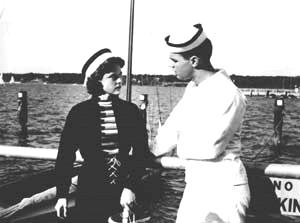 |
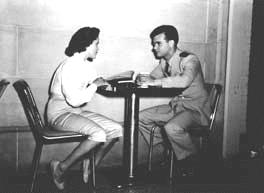 |
|
| Actors Barbara Whiting and Darryl Hickman in a scene from the episode titled "Willie," in the 1957 series Men of Annapolis. Hickman later appeared with his brother in the TV series Dobie Gillis ('59-'63). | Actors Barbara Whiting and Darryl Hickman share geduck in the Steerage in a scene from an episode titled "Willie," a story of a Midshipman and his romance with a yard engine. |
In a letter to Rear Admiral Smedberg dated 29 August 1957, Dorso of ZIV enclosed a page from the August 21st edition of Variety showing Men of Annapolis ranked in the top ten syndicated shows in New York, Chicago, Los Angeles, Cleveland and Atlanta. Trumpeting this successful showing, he wrote: "The appearance in the ratings in every one of these cities of Men of Annapolis is truly remarkable. These ratings indicate that Men of Annapolis is reaching a large segment of the television viewing audience."
Despite the show’s apparent popularity, the
Naval Academy was having second thoughts about the advisability of a second
season for Men of Annapolis. On the 26th of August, just prior to
receiving Dorso’s letter, the Superintendent reported his impressions to
the Chief of Naval Information after reviewing the last of the 39 episodes:
"It is suspected that... [the series] has been adequate as advertising
and promotion for the Naval Academy." But, Admiral Smedberg also revealed
a negative consensus among "those who had been associated with the Navy,
either directly or indirectly" that ranged from appeals to put an immediate
stop to the series to general dislike for the tone and story lines. He
closed his letter by recommending, "In the opinion of the Naval Academy,
the series should not be renewed. It is realized that ‘Men of Annapolis’
was conceived as a dramatic rather than documentary series,
but the writers have almost exhausted the
|
|
Commencing in the fall of 1958, the series
went to syndicated re-runs on many stations throughout the country.
| In hindsight, the decision process that led to termination of the series may have failed to appreciate fully the impact the program was having on potential Midshipmen. Several alumni had comments similar to those of Larry Schadegg ’69, who wrote of being 13, living on a Minnesota farm, and getting his first exposure to USNA: "For me, this series provided the initial motivation right at that critical time when a young person is... looking for object lessons." R. D. (Bob) Brown, Jr. ’65 commented, "I do remember them [the stories of Men of Annapolis] reinforcing a strong moral code of ethics... the shows were great motivators for young people." |
|
With the Navy’s decision to end its participation, the Secretary of the Navy awarded a Certificate of Merit to ZIV, "For outstanding service... ZIV Television has brought to nearly fifty million viewers each week an accurate picture of the life and training of Midshipmen... The quality of the programs—with the stress on standards of morality and the values of honor as they are stressed at the Naval Academy—has promoted nation-wide understanding of the purposes, ideals, and achievements of the Navy." A year later, in a letter dated 14 November 1958, the Academy’s PIO Officer, Commander Marcy Dupre, summarized his opinion of the value of Men of Annapolis: "Our only real yardstick is the overall increase in the number of candidates who have applied for entrance since the inception of the series, coupled with the upsurge in correspondence from people all over the country... I feel that Men of Annapolis had no small part in telling the Naval Academy’s story to the public and was, therefore, of significant value."
Now, four decades later, the results of my informal survey of the classes of ’62 to ’69 would seem to confirm Commander Dupre’s summary and indicate that the 1957 series Men of Annapolis had achieved the "intended and desired effect; that of telling the people of the United States about their Naval Academy in such a way that young men of high purpose, who seek and welcome responsibility, will be encouraged to make the Navy their career via the Academy."
According to Jack Feehan ’67: "I guess we are the
first generation that was influenced by Television. In the case of Men
of Annapolis, this was a very positive influence." Quoting Bob Brown
’65: "I was hooked! It doesn’t always take a lot to inspire a dream, and
that was all I needed."
After his experience with Men of Annapolis, Bud Alexander ’56 went on to a submarine career and command of COBBLER (SS-344). He also commanded the Recruit Training Command, Great Lakes and served as Chief of Staff for ComSubMed. He retired in 1986 from the position of Military Assistant for Strategic and Theater Nuclear Systems, Office of the Under Secretary of Defense for Research and Engineering. Bud now lives in St. Petersburg, FL.
| This page posted:
24 November 1999 |
Navigate to: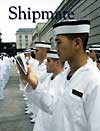 Shipmate Index |
 Quarterdeck |
Wardroom |
Site Map |
USNA63 |